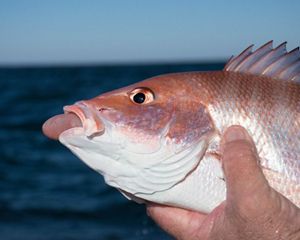Protecting the Future of Fish
The Nature Conservancy is collecting data on fish reproduction that can help guide future ocean protection.
As the new moon approaches each January, large numbers of adult gag grouper travel to specific reefs along the edge of South Carolina’s continental shelf. Once conditions are right, the fish begin to spawn (reproduce). They’ll stay there for several days before returning to their rocky-bottom homes. The fish will make the same spawning pilgrimage several more times before the end of April.
Predictable spawning patterns occur in many bottom-dwelling fish, including grouper, snapper and scamp. They make these species extraordinarily vulnerable to overfishing.
“Fishing during spawning is like fishing in a barrel,” says Liz Fly, Ph.D., director of resilience and ocean conservation for The Nature Conservancy in South Carolina. “It’s easy to catch lots of fish in a short period of time. That can lead to population decline.”
Why is overfishing so dangerous?
It’s easy to see why bottom-dwelling fish like grouper, snapper and scamp are desirable for fishermen. They’re good eating!
Some popular eating fish, including mahi and tilapia, can reproduce at only a few months old and only live about three to six years in the wild. By contrast, gag grouper take six years to reach sexual maturity and can live for another 20 years beyond that. That long interval between birth and reproduction means grouper are vulnerable to being caught faster than they can be replaced. And because of their long lifespan, each grouper taken out of the water means a possible loss of decades of reproduction.
Quote: Liz Fly
By definition, fish being caught while spawning are at a size and age to reproduce, so removing fish from these areas in the long term can change the population dynamics. You’d still have very old and very young fish in the water, but not that reproductive base in between.
Other threats impact fish populations.
While we think of gag grouper as a deepwater fish, it spends the first part of its life cycle much closer to shore. Salt marshes and oyster reefs are its prime habitat at the juvenile stage. Coastal development, excessive oyster harvesting or other activities that degrade these areas can impact fish populations.
What we’re doing to benefit fish populations.
In 2017, the South Atlantic Fishery Management Council (SAFMC) designated five Spawning Special Management Zones (SSMZs) off the coasts of South Carolina, Georgia and Florida. These areas were closed to fishing for 10 years to protect grouper, scamp and other deepwater fish at their vulnerable reproductive stage. Although the council intended to collect more data on spawning activity during that time, only limited monitoring has occurred.
With the SAFMC’s 10-year deadline looming (expiration 2027), The Nature Conservancy sent two research trips to the Georgetown Hole SSMZ located off the coast of South Carolina in 2023 and 2024. The vessels sampled fish for evidence of spawning—such as enlarged ovaries—and used underwater cameras to record courtship behaviors. TNC hopes to secure funding for more research trips in 2025 and 2026 to secure the data needed by SAFMC to decide on future protections.





